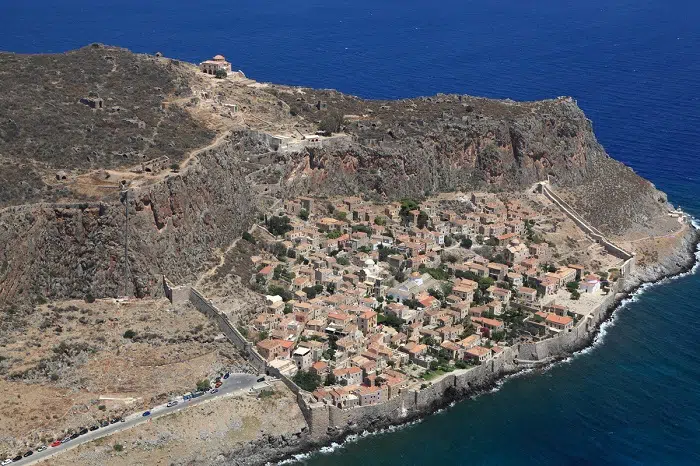
Monemvasia, one of Europe’s oldest continuously inhabited castle towns in Peloponnese, Greece will soon be equipped with a cable car making it fully accessible by 2024.
The cable car, budgeted at 6.8 million euros will connect to the upper town (Ano Poli). The project, which includes the supply, installation, and operation of the cable car and was initially announced by Culture Minister Lina Mendoni in 2021, will be funded through recovery and resilience (RRF) funds.
“The castle town of Monemvasia is a special monumental and residential complex, where the active settlement of the lower town coexists with the archaeological site of the upper town,” Mendoni said earlier in the week.
“With the projects we are already implementing – the installation of a cable car, the conversion of the Yannis Ritsos house into a Municipal Museum, the illumination of the Rock, the restoration of the walls – but also those that have already been completed, such as the restoration of the Church of Agia Sophia in Ano Town, our goal is to highlight Monemvasia as a whole, connecting the Upper Town with the Lower Town, making it completely accessible to every visitor,” she added.
Founded in 583 by inhabitants of the mainland seeking refuge from the Slavic and the Avaric invasion of Greece and surrounded by the Myrtoan Sea, Monemvasia is located on an island about half a mile long.
A man-made road and stone bridge leads to the castle gate and main entrance of the majestic castle town onward through the colorful and lively citadel offering all who visit her both stunning views and an unforgettable ‘ambiance’ of times past.
The fortress’ stone walls protected the citadel of Monemvasia from various invaders throughout its history. Invasions by the Crusaders, Venetians, and lastly, by the Ottomans have all left an indelible cultural and architectural mark, granting the citadel a unique charm and romantic atmosphere close to none.
Few places in Greece possess the combined charm, natural beauty, and historical significance to the extent that Monemvasia does.
The town’s name is derived from two Greek words, mone and emvasia, meaning “single entrance.” The “Gibraltar of the East” or a “stone ship” about to set sail, as the famous Greek poet Yannis Ritsos described his birthplace, beckons you for a journey through time, wandering through vaulted alleyways and past churches and aristocratic mansions.
Cable car to help visitors visit the upper town of Monemvasia
At present, one can reach the upper town or ‘acropolis’ by climbing up the narrow pathway that leads to the summit from the main square.
On the summit, one can enjoy a breathtaking view of the fortress city below, surrounded by the sea. Positioned on the very edge of the cliff there is a single building still left standing, the recently restored church of St. Sophia which was built in the 12th century A.D.
Once an invincible fortress, the Upper Town was home to the aristocracy of Monemvasia.
During the 17th century A.D. there were more than 500 mansions on the upper slopes of the castle citadel. Today, very little is left to remind this rich local history if not, the stone ruins and cisterns that are scattered amongst the wildflowers and bushes that hide its glorious past.
The ‘acropolis’ situated on the very tip of the rock is approximately 300 mts. from sea level.